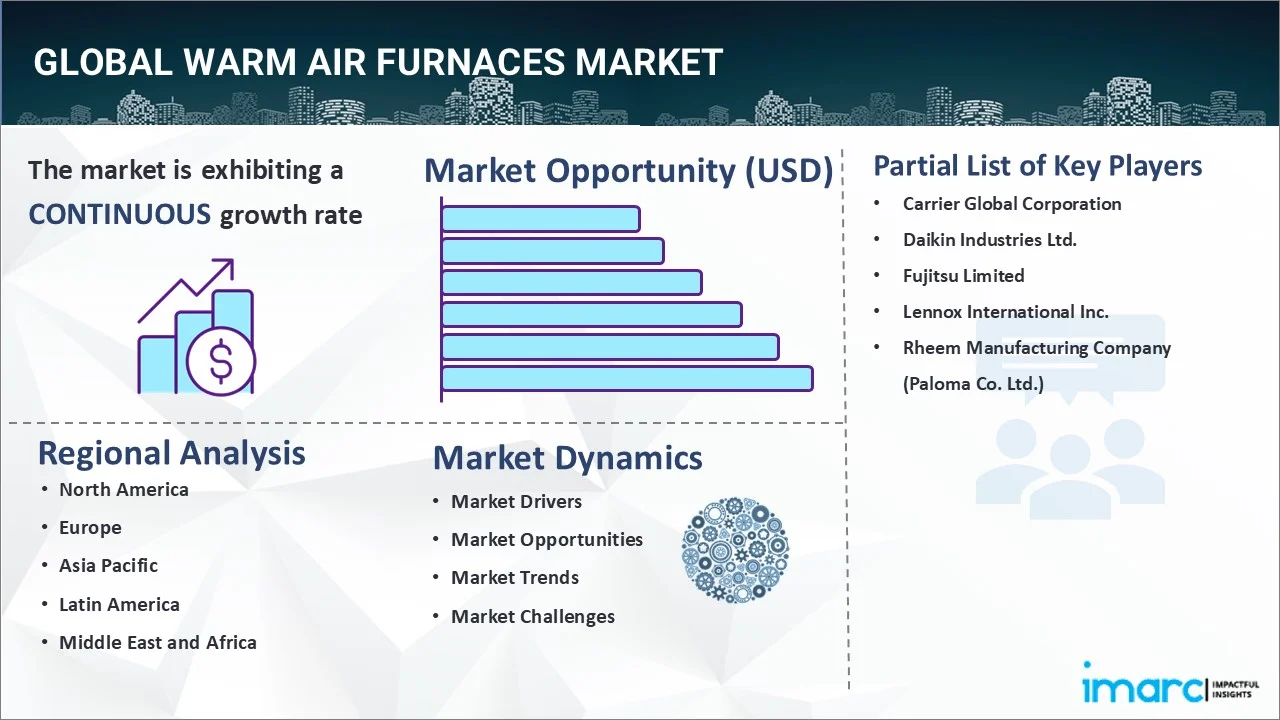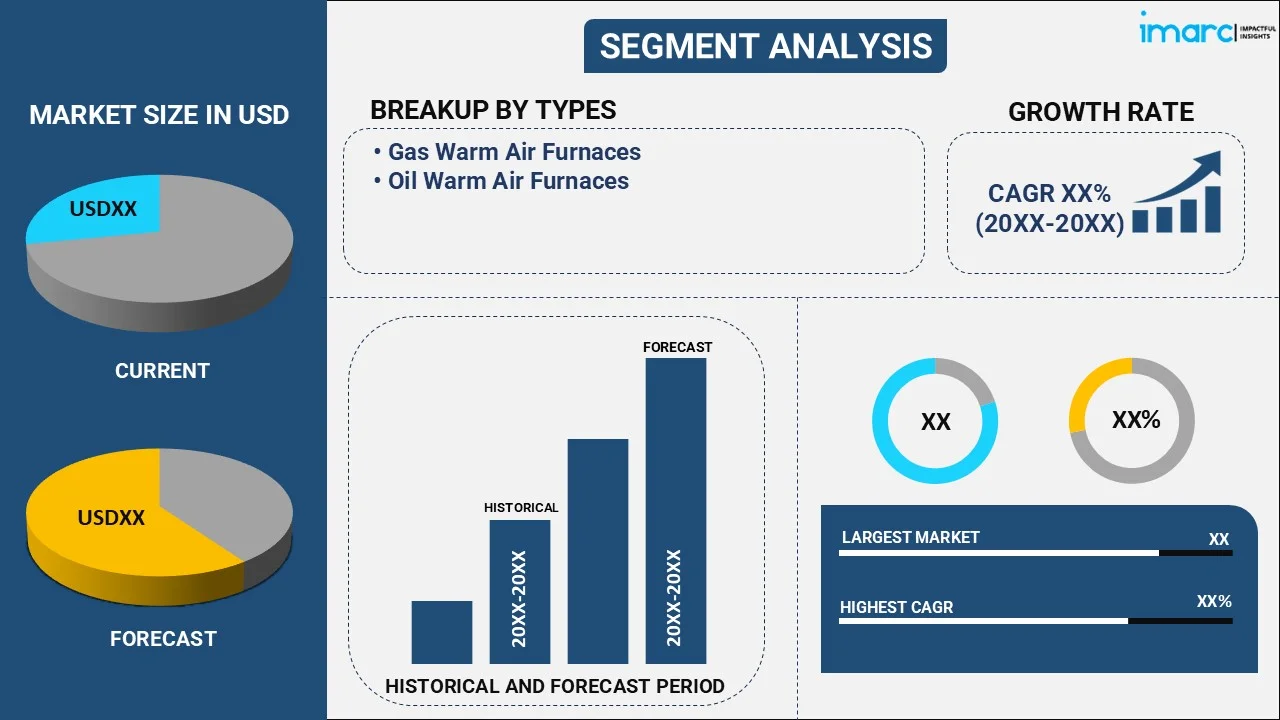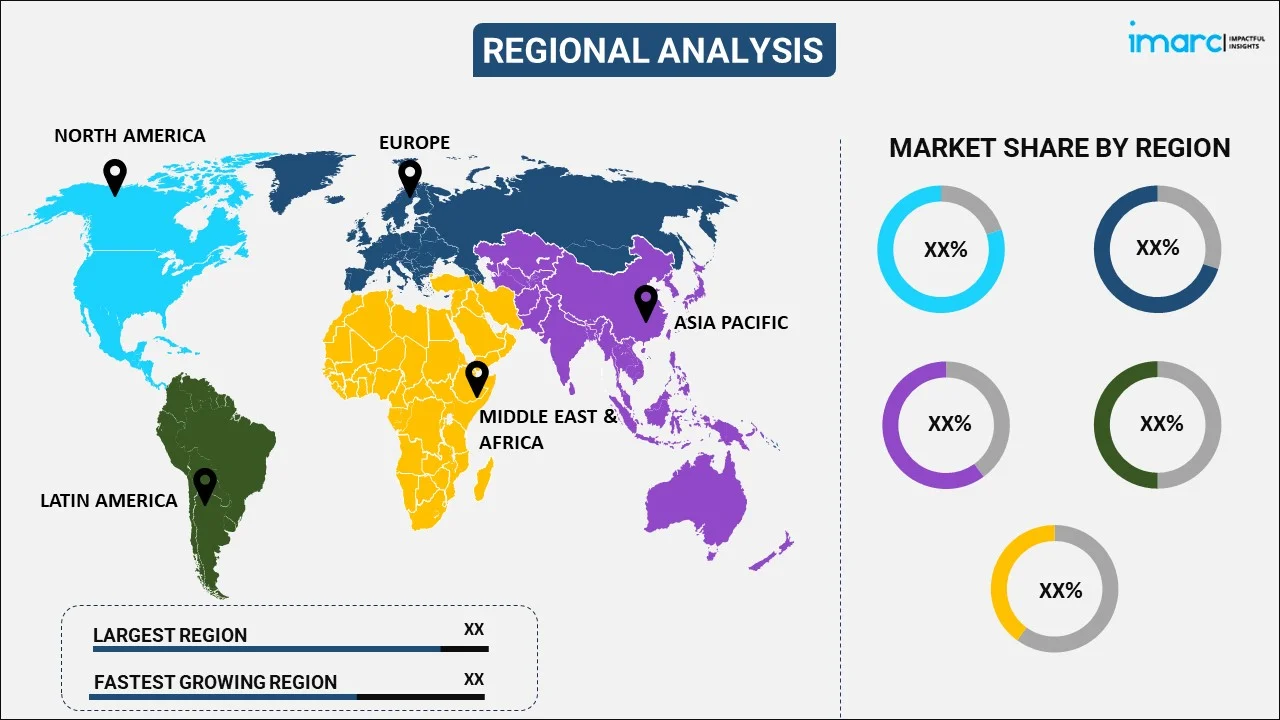
Warm Air Furnaces Market Report by Type (Gas Warm Air Furnaces, Oil Warm Air Furnaces), Application (Residential, Commercial, Industrial), and Region 2025-2033
Market Overview:
The global warm air furnaces market size reached USD 9.1 Billion in 2024. Looking forward, IMARC Group expects the market to reach USD 12.0 Billion by 2033, exhibiting a growth rate (CAGR) of 2.84% during 2025-2033. The increasing emphasis on energy efficiency and sustainability, growing demand for HVAC systems, significant technological advancements, changing consumer preferences, and rising awareness about indoor quality are some of the major factors propelling the market.
|
Report Attribute
|
Key Statistics
|
|---|---|
|
Base Year
|
2024 |
|
Forecast Years
|
2025-2033
|
|
Historical Years
|
2019-2024
|
| Market Size in 2024 | USD 9.1 Billion |
| Market Forecast in 2033 | USD 12.0 Billion |
| Market Growth Rate (2025-2033) | 2.84% |
Warm air furnaces, also known as forced-air furnaces, are a type of heating system commonly used in residential and commercial buildings. These furnaces operate by heating air and then distributing it throughout the building via ducts and vents. The process begins with the furnace's burners igniting a fuel source, such as natural gas or oil, within a combustion chamber. As the fuel burns, it releases heat energy, which is transferred to a heat exchanger. The heat exchanger warms the surrounding air as it passes over its surface. Once heated, the air is propelled by a blower fan through a network of ducts that traverse the structure, effectively distributing the warmed air to various rooms. They can be equipped with air filters and humidifiers, enhancing indoor air quality and comfort. However, it's essential to ensure proper maintenance to prevent issues like air leaks, inefficient combustion, or deteriorating air quality.

With the increasing emphasis on energy conservation and environmental sustainability, consumers are seeking heating solutions that are energy-efficient and eco-friendly. Warm air furnaces, when equipped with advanced technologies, such as variable-speed blowers and high-efficiency burners, offer significant energy savings, attracting environmentally conscious consumers. Additionally, the growth of the construction sector, both residential and commercial, drives the demand for HVAC (Heating, Ventilation, and Air Conditioning) systems, including warm air furnaces. As new buildings are constructed and existing structures are renovated, the need for efficient heating solutions propels the warm air furnaces market forward. Other than this, consumer preferences have shifted towards convenience and comfort. Warm air furnaces offer rapid and consistent heating, reducing the waiting time for a comfortable indoor environment. This convenience factor has made warm air furnaces an attractive choice, driving their adoption. Besides this, as existing heating systems age or become obsolete, consumers opt to replace or upgrade them with more efficient models. This replacement cycle is a significant driver of the warm air furnaces market, particularly in regions where older systems are prevalent. In line with this, warm air furnaces can be equipped with air filtration and purification systems, enhancing indoor air quality by removing allergens, pollutants, and contaminants. The growing awareness of the importance of indoor air quality is spurring demand for furnaces that contribute to healthier living environments. Furthermore, ongoing advancements in furnace technologies have led to the development of smarter, more controllable warm air furnaces. Integration with smart home systems, Wi-Fi connectivity, and programmable thermostats enhance user experience and convenience, thereby boosting market demand. Moreover, economic stability and disposable income levels impact consumer spending on home improvement and comfort-related products. A robust economy often leads to increased investments in heating systems, thereby bolstering the warm air furnaces market.
Warm Air Furnaces Market Trends/Drivers:
Energy Efficiency and Sustainability
Consumers are increasingly conscious of their environmental impact and energy consumption. Warm air furnaces equipped with advanced features, such as high-efficiency burners and variable-speed blowers, offer significant energy savings compared to older models. This reduces utility bills and also aligns with eco-friendly practices, attracting a growing segment of environmentally conscious buyers. As governments implement stricter energy efficiency regulations, the demand for such furnaces is likely to escalate. For market research and consulting services, understanding the role of energy efficiency in driving warm air furnace adoption is crucial in advising manufacturers on optimizing product offerings.
Rising Demand for HVAC Systems
The booming construction industry, both in residential and commercial sectors, is fueling the demand for comprehensive HVAC systems, including warm air furnaces. As new buildings are erected and older ones refurbished, the need for efficient heating solutions is amplified. Warm air furnaces stand out due to their ability to swiftly heat spaces, offering immediate comfort. The expanding urban landscape and growing middle-class population in emerging economies further propel this demand. Market research and consulting firms can assist HVAC manufacturers by identifying regions experiencing rapid construction growth and providing insights into effective market entry strategies.
Significant Technological Advancements
The integration of cutting-edge technologies like smart home compatibility, Wi-Fi connectivity, and programmable thermostats enhances user experience. Homeowners can now control their furnaces remotely, adjusting settings for optimal comfort and energy savings. This level of convenience aligns with modern lifestyles and attracts tech-savvy consumers. Market research professionals can aid companies by tracking consumer preferences for technological features and analyzing which innovations resonate most strongly with different demographics. This information can guide manufacturers in developing products that cater to evolving customer expectations, thus maintaining a competitive edge in the market.
Warm Air Furnaces Industry Segmentation:
IMARC Group provides an analysis of the key trends in each segment of the global warm air furnaces market report, along with forecasts at the global, regional, and country levels from 2025-2033. Our report has categorized the market based on type and application.
Breakup by Type:

- Gas Warm Air Furnaces
- Oil Warm Air Furnaces
Gas warm air furnaces dominate the market
The report has provided a detailed breakup and analysis of the market based on the type. This includes gas warm air furnaces and oil warm air furnaces. According to the report, gas warm air furnaces represented the largest segment.
Gas furnaces utilize natural gas as a fuel source, which is widely accessible in many regions. This accessibility contributes to their popularity among consumers and businesses alike. Furthermore, gas furnaces are known for their efficient heating capabilities, providing a quick and consistent source of warmth. This efficiency aligns with the growing emphasis on energy conservation and cost reduction, making gas furnaces an attractive choice for many households and commercial spaces. In addition, advancements in technology have led to the development of high-efficiency gas furnaces that offer improved energy performance and reduced environmental impact. These factors not only address heating needs but also align with sustainable practices, which is an important consideration for consumers and industries seeking responsible heating solutions.
Breakup by Application:
- Residential
- Commercial
- Industrial
Commercial holds the largest share in the market
A detailed breakup and analysis of the market based on the application has also been provided in the report. This includes residential, commercial, and industrial. According to the report, commercial applications accounted for the largest market share.
Commercial spaces, such as office buildings, retail outlets, and industrial facilities, require efficient and reliable heating solutions to maintain optimal working conditions for employees, customers, and operations. Warm air furnaces offer a practical and effective means of achieving consistent warmth in these diverse settings. Additionally, the scale of commercial spaces often demands heating systems that can cover expansive areas efficiently. Warm air furnaces are well-suited for this purpose, as they can quickly distribute heated air throughout large spaces, ensuring even and comfortable temperatures. This efficiency contributes to cost savings and energy conservation, aligning with the priorities of commercial enterprises focused on operational efficiency and sustainable practices. Furthermore, the adaptability of warm air furnaces to different heating requirements, whether for open workspaces, enclosed offices, or specialized industrial zones, makes them versatile solutions for diverse commercial applications.
Breakup by Region:

- North America
- United States
- Canada
- Europe
- Germany
- France
- United Kingdom
- Italy
- Spain
- Others
- Asia Pacific
- China
- Japan
- India
- South Korea
- Australia
- Indonesia
- Others
- Latin America
- Brazil
- Mexico
- Others
- Middle East and Africa
North America exhibits a clear dominance in the market
The report has also provided a comprehensive analysis of all the major regional markets, which include North America (the United States and Canada); Europe (Germany, France, the United Kingdom, Italy, Spain, and others); Asia Pacific (China, Japan, India, South Korea, Australia, Indonesia, and others); Latin America (Brazil, Mexico, and others); and the Middle East and Africa. According to the report, North America was the largest market.
The diverse climate of North America which includes cold winters in many areas, drives a substantial demand for effective and efficient heating solutions. Warm air furnaces have emerged as a preferred choice for homeowners and businesses alike, offering rapid and consistent heating that addresses the specific needs of the North American climate. Moreover, the prevalence of residential and commercial spaces in North America, coupled with a well-established infrastructure, has fostered a robust market for warm air furnaces. As housing and construction activities continue to flourish, the demand for reliable heating solutions remains consistently high. Additionally, advancements in technology have led to the development of energy-efficient warm air furnaces that align with the region's growing emphasis on sustainability. Consumers and businesses are seeking heating options that not only provide comfort but also minimize energy consumption and environmental impact. This aligns well with the capabilities of modern warm air furnaces, further propelling their popularity in the North American market.
Competitive Landscape:
Leading manufacturers are investing heavily in research and development to introduce innovative features and technologies in their warm air furnace offerings. This includes integrating smart controls, energy-efficient components, and advanced air quality enhancement systems. By continuously enhancing product capabilities, these players attract consumers seeking cutting-edge solutions for efficient and comfortable heating. Additionally, understanding consumer preferences is crucial. Key players engage in comprehensive market research to identify customer needs and pain points. This knowledge informs product design, ensuring that warm air furnaces address specific requirements, such as energy savings, ease of use, and indoor air quality improvements. By tailoring products to meet these demands, these companies build strong customer loyalty and positive brand perception. Other than this, to capitalize on emerging markets and new growth opportunities, major players are strategically expanding their geographical presence. They establish distribution networks, partnerships, and collaborations in regions experiencing high construction activity and demand for heating systems. This approach allows them to tap into previously untapped markets and diversify revenue streams. Other than this, recognizing the importance of informed consumers, key players engage in educational initiatives. They provide resources and guides about the benefits of warm air furnaces, energy efficiency, maintenance, and choosing the right system. These efforts not only enhance consumer knowledge but also position the companies as thought leaders and trusted advisors in the heating industry.
The market research report has provided a comprehensive analysis of the competitive landscape in the market. Detailed profiles of all major companies have also been provided. Some of the key players in the market include:
- Carrier Global Corporation
- Daikin Industries Ltd.
- Fujitsu Limited
- Lennox International Inc.
- Rheem Manufacturing Company (Paloma Co. Ltd.)
Warm Air Furnaces Market Report Scope:
| Report Features | Details |
|---|---|
| Base Year of the Analysis | 2024 |
| Historical Period | 2019-2024 |
| Forecast Period | 2025-2033 |
| Units | Billion USD |
| Scope of the Report | Exploration of Historical and Forecast Trends, Industry Catalysts and Challenges, Segment-Wise Historical and Predictive Market Assessment:
|
| Types Covered | Gas Warm Air Furnaces, Oil Warm Air Furnaces |
| Applications Covered | Residential, Commercial, Industrial |
| Regions Covered | Asia Pacific, Europe, North America, Latin America, Middle East and Africa |
| Countries Covered | United States, Canada, Germany, France, United Kingdom, Italy, Spain, China, Japan, India, South Korea, Australia, Indonesia, Brazil, Mexico |
| Companies Covered | Carrier Global Corporation, Daikin Industries Ltd., Fujitsu Limited, Lennox International Inc., Rheem Manufacturing Company (Paloma Co. Ltd.), etc. |
| Customization Scope | 10% Free Customization |
| Post-Sale Analyst Support | 10-12 Weeks |
| Delivery Format | PDF and Excel through Email (We can also provide the editable version of the report in PPT/Word format on special request) |
Key Questions Answered in This Report:
- How has the global warm air furnaces market performed so far, and how will it perform in the coming years?
- What are the drivers, restraints, and opportunities in the global warm air furnaces market?
- What is the impact of each driver, restraint, and opportunity on the global warm air furnaces market?
- What are the key regional markets?
- Which countries represent the most attractive warm air furnaces market?
- What is the breakup of the market based on the type?
- Which is the most attractive type in the warm air furnaces market?
- What is the breakup of the market based on the application?
- Which is the most attractive application in the warm air furnaces market?
- What is the competitive structure of the global warm air furnaces market?
- Who are the key players/companies in the global warm air furnaces market?
Key Benefits for Stakeholders:
- IMARC’s industry report offers a comprehensive quantitative analysis of various market segments, historical and current market trends, market forecasts, and dynamics of the warm air furnaces market from 2019-2033.
- The research report provides the latest information on the market drivers, challenges, and opportunities in the global warm air furnaces market.
- The study maps the leading, as well as the fastest-growing, regional markets. It further enables stakeholders to identify the key country-level markets within each region.
- Porter's five forces analysis assist stakeholders in assessing the impact of new entrants, competitive rivalry, supplier power, buyer power, and the threat of substitution. It helps stakeholders to analyze the level of competition within the warm air furnaces industry and its attractiveness.
- Competitive landscape allows stakeholders to understand their competitive environment and provides an insight into the current positions of key players in the market.
Need more help?
- Speak to our experienced analysts for insights on the current market scenarios.
- Include additional segments and countries to customize the report as per your requirement.
- Gain an unparalleled competitive advantage in your domain by understanding how to utilize the report and positively impacting your operations and revenue.
- For further assistance, please connect with our analysts.
 Inquire Before Buying
Inquire Before Buying
 Speak to an Analyst
Speak to an Analyst
 Request Brochure
Request Brochure
 Request Customization
Request Customization




.webp)




.webp)












